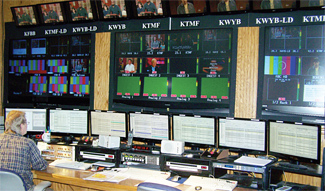Max Media Centralcasts with Harris

The Max Media of Montana master control center
MISSOULA, MONT.
Max Media of Montana owns and operates six stations across the state. Our centralized technical operation is based in Missoula and manages 12 HD channels evenly divided between the six stations.
Centralcasting is key to economizing broadcast operations in the digital age and this is an important consideration for any local TV station today. For us, centralizing operations included establishing a broadcast server cluster for all stations which would serve as the core of our master control.
After much evaluation, we selected the Harris advanced media platform that was made up of five Nexio AMP 3601HDI servers with an external storage array accommodating two weeks of storage. We also implemented the Nexio Playlist Manager for playout of sequenced content. I was familiar with Nexio, based on experience with previous-generation servers while working for another station group. The servers were reliable, had proven themselves flexible in a centralcasting environment, and my experience with Harris technical support had been very satisfactory.
MANAGING WORKFLOW
Our master control center is essentially a manual operation with automated elements. There are nine master control operators, with three on duty at any given time, sharing responsibility for managing ingest and playout functions for all channels. Ingest is almost completely manual, with operators quality-checking audio levels on every program and advertisement. The daily ingest process begins around midnight, with operators manually loading playlists via Playlist Manager. Ad data is first imported via a Harris OSi-Traffic system, with customized scripting that enables an automated workflow between the two systems. The OSi files are converted and added to the playlists, with quality checks to ensure there are no extraneous issues with scripts and markers.
The playlists are then manually sequenced to ensure that operators are listening to the programs and commercial spots and are confirming audio quality. The servers seamlessly play out the day's programming for each station. Operators occasionally use GPI/O control systems to trigger spots.
MANUAL CONTROL IS AN IMPORTANT FACTOR
This GPI/O control capability was also an important selling point. Our previous server relied solely on TCP/IP control, which didn't always perform to our requirements. We hard-wired existing control panels to GPI/O interfaces on the Nexio AMP platform, and this functionality has saved us the expense of a full-blown automation system.
Our operators can selectively start or stop any playlist on any of our stations by simply flipping a switch and pressing a button.
The Nexio AMP has integrated effectively into our existing core. The servers interoperate well with our Harris OSi-Traffic system and third-party equipment. The interface between Nexio AMP and our router is very reliable and is powered by our GPI/O system. The real beauty is that the Nexio interface allowed us to build this entire system ourselves.
And while certain elements of our operation are manual, the data flow between Nexio AMP and OSi runs as efficiently as any automation system I've seen. This workflow and interoperability will also be beneficial when it's time to make upgrades to our networking and infrastructure.
Roger Hatcher is engineering supervisor for Max Media of Montana, headquartered in Missoula. He may be contacted atrhatcher@maxmontana.com.
For additional information, contact Harris Broadcast at 800-231-9673 or visitwww.broadcast.harris.com.
The professional video industry's #1 source for news, trends and product and tech information. Sign up below.
